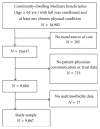Type of Multimorbidity and Patient-Doctor Communication and Trust among Elderly Medicare Beneficiaries
- PMID: 27800181
- PMCID: PMC5069353
- DOI: 10.1155/2016/8747891
Type of Multimorbidity and Patient-Doctor Communication and Trust among Elderly Medicare Beneficiaries
Abstract
Background. Effective communication and high trust with doctor are important to reduce the burden of multimorbidity in the rapidly aging population of the US. However, the association of multimorbidity with patient-doctor communication and trust is unknown. Objective. We examined the relationship between multimorbidity and patient-doctor communication and trust among the elderly. Method. We used the Medicare Current Beneficiary Survey (2012) to analyze the association between multimorbidity and patient-doctor communication and trust with multivariable logistic regressions that controlled for patient's sociodemographic characteristics, health status, and satisfaction with care. Results. Most elderly beneficiaries reported effective communication (87.5-97.5%) and high trust (95.4-99.1%) with their doctors. The elderly with chronic physical and mental conditions were less likely than those with only physical conditions to report effective communication with their doctor (Adjusted Odds Ratio [95% Confidence Interval] = 0.80 [0.68, 0.96]). Multimorbidity did not have a significant association with patient-doctor trust. Conclusions. Elderly beneficiaries had high trust in their doctors, which was not affected by the presence of multimorbidity. Elderly individuals who had a mental condition in addition to physical conditions were more likely to report ineffective communication. Programs to improve patient-doctor communication with patients having cooccurring chronic physical and mental health conditions may be needed.
Similar articles
-
Associations of multimorbidity and patient-reported experiences of care with conservative management among elderly patients with localized prostate cancer.Cancer Med. 2020 Aug;9(16):6051-6061. doi: 10.1002/cam4.3274. Epub 2020 Jul 6. Cancer Med. 2020. PMID: 32628817 Free PMC article.
-
Type of Multimorbidity and Propensity to Seek Care among Elderly Medicare.J Health Dispar Res Pract. 2017 Winter;10(4):34-51. J Health Dispar Res Pract. 2017. PMID: 31236309 Free PMC article.
-
Aspects of culturally competent care are associated with less emotional burden among patients with diabetes.Med Care. 2012 Sep;50(9 Suppl 2):S69-73. doi: 10.1097/MLR.0b013e3182641127. Med Care. 2012. PMID: 22895234
-
Medicare Beneficiaries With a Specialist as Their Personal Doctor Report Better Experiences With Care.Med Care. 2019 Jun;57(6):453-459. doi: 10.1097/MLR.0000000000001122. Med Care. 2019. PMID: 31008897
-
Multimorbidity, Mental Illness, and Quality of Care: Preventable Hospitalizations among Medicare Beneficiaries.Int J Family Med. 2012;2012:823294. doi: 10.1155/2012/823294. Epub 2012 Dec 20. Int J Family Med. 2012. PMID: 23320168 Free PMC article.
Cited by
-
Patient perception of doctor communication skills and patient trust in rural primary health care: the mediating role of health service quality.BMC Prim Care. 2022 Sep 29;23(1):255. doi: 10.1186/s12875-022-01826-4. BMC Prim Care. 2022. PMID: 36175839 Free PMC article.
-
Association Between Patient-Clinician Relationships and Adherence to Antihypertensive Medications Among Black Adults: An Observational Study Design.J Am Heart Assoc. 2021 Jul 20;10(14):e019943. doi: 10.1161/JAHA.120.019943. Epub 2021 Jul 9. J Am Heart Assoc. 2021. PMID: 34238022 Free PMC article.
-
Patients' sense of responsibility to healthcare providers and its predictors: A national cross-sectional survey in China.PLoS One. 2018 Dec 5;13(12):e0207361. doi: 10.1371/journal.pone.0207361. eCollection 2018. PLoS One. 2018. PMID: 30517118 Free PMC article.
-
The impact of contract service policy and doctor communication skills on rural patient-doctor trust relationship in the village clinics of three counties.BMC Health Serv Res. 2019 Mar 22;19(1):187. doi: 10.1186/s12913-019-3875-x. BMC Health Serv Res. 2019. PMID: 30902058 Free PMC article.
-
Associations of multimorbidity and patient-reported experiences of care with conservative management among elderly patients with localized prostate cancer.Cancer Med. 2020 Aug;9(16):6051-6061. doi: 10.1002/cam4.3274. Epub 2020 Jul 6. Cancer Med. 2020. PMID: 32628817 Free PMC article.
References
-
- Mendoza M. D., Smith S. G., Eder M. M., Hickner J. The seventh element of quality: the doctor-patient relationship. Family Medicine. 2011;43(2):83–89. - PubMed
-
- Beck R. S., Daughtridge R., Sloane P. D. Physician-patient communication in the primary care office: a systematic review. Journal of the American Board of Family Practice. 2002;15(1):25–38. - PubMed
Grants and funding
LinkOut - more resources
Full Text Sources
Other Literature Sources


